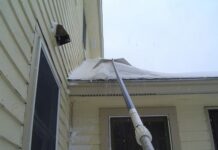By Melissa Rayworth
When decorating our homes, we tend to consider things like beauty and comfort, the durability of pieces we might buy or the image they project. But how many of us stop to consider our energy bills?
Energy-smart design goes way beyond choosing Energy Star-rated appliances or switching to compact fluorescent bulbs, although both are good ideas. Today’s experts see opportunities to conserve energy in nearly every aspect of home design.
There are “so many things that look gorgeous and totally save you money,” said interior designer Brian Patrick Flynn.
We asked Flynn and fellow designers Mallory Mathison and Janine Carendi to share their energy-wise secrets:
Windows
Add a layer of heavy “blackout” lining to the back of draperies (DIY or hire a seamstress), Flynn said. “It makes the drapes hang better, and gives them a richer, more full look,” he said. The barrier helps keep out noise pollution, as well as light in summer and cold in winter, he said.
As you do with clothing, insulate with layers: Mathison suggests layered window treatments “with a wool sheer and then an outer panel” of heavier fabric.
Check all windows for drafts, Carendi said, and plug holes, or consider replacing windows or repairing window frames. “You would be shocked how much heat you lose,” she said, from windows that aren’t properly sealed or insulated.
All three designers recommend UV-protectant film, made by 3M to keep heat out in summer and protect furniture from fading (bonus: some versions also enhance security).
Lighting/electronics
Swapping out bulbs is a great energy-saving first step. The earliest generations of compact fluorescent bulbs gave off a harsh light that turned off some consumers, but newer versions offer softer, more appealing light.
Next, Carendi recommends replacing old dimmers with energy-smart models (she likes Lutron).
The designers also suggest using power strips or other devices that make it simpler to switch off electronics at night. Eliminating energy usage from items you don’t use overnight can provide real savings.
Floors
Add thick, warm, wool area rugs. Warm feet may help you resist cranking up the heat, said Mathison, and the sight of a plush rug can make you feel cozier. You can keep lightweight rugs for summer, but swap them out when temperatures drop: “If you have standard sea grass rugs,” said Mathison, “then in winter try adding a wool or cotton flat-weave rug.” She also mentions radiant-heated floors.
To warm up stairs and hallways, Flynn has a neat tip: Avoid the expense of having custom rugs made for these narrow spaces by buying a rectangular area rug and having it cut into strips measured to the correct width. Have the strips bound (most carpet stores will do it or recommend a binder in the area) and then attached end-to-end to create a single piece the right length.
Appliances
It can be wise to invest a bit more upfront for items with a good Energy Star rating.
Also, said Carendi, “train yourself to look beyond styles of appliances that you’re comfortable with. Some of the European brands are highly energy-efficient, but they may not have a look that’s as comfortable to you at first.”
Another way to conserve: Flynn has several clients who have installed built-in coffee/espresso systems that use a predetermined amount of water. Rather than using the power and water needed to brew an entire pot of coffee each morning, they brew a single cup.
Fabrics
Carendi suggests keeping cashmere throws or other small coverlets on hand. “My husband always puts down the heat,” she said, “so I have throws all over my apartment, because they look great and they are so warm — cashmere especially.”
If you’re changing upholstery, said Flynn, consider having the sofa covered in a warm fabric like flannel, then having a light linen slipcover made for summer.
And Mathison advises that walls be insulated as much as possible: “When people used to hang tapestries, they were hung for insulating purposes,” she said. “Using grass cloth as wallpaper would be more insulating than regular wallpaper,” she said, and even adding wood paneling will help conserve energy.
“It adds texture and interest, and makes things a little bit warmer.”
Lastly, all three designers point out that to lessen your home’s carbon footprint you can buy things manufactured or crafted locally, rather than those transported from far away. And comb flea markets and antique shops for pre-used items.
“Antiques are the best way to save energy, because they’ve already been produced,” Carendi said. “As beautiful as they tend to be, you’re not buying something new.” — AP












